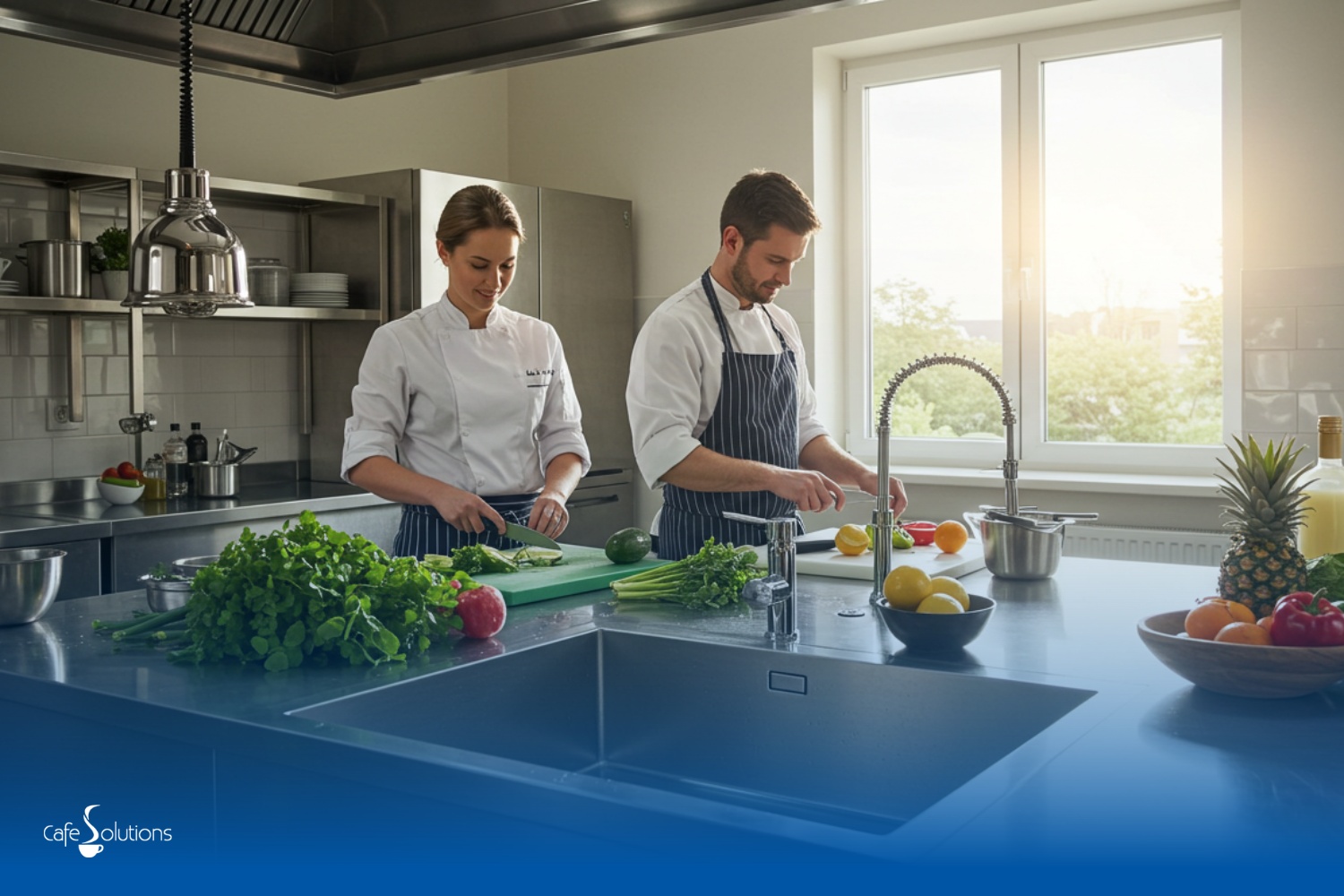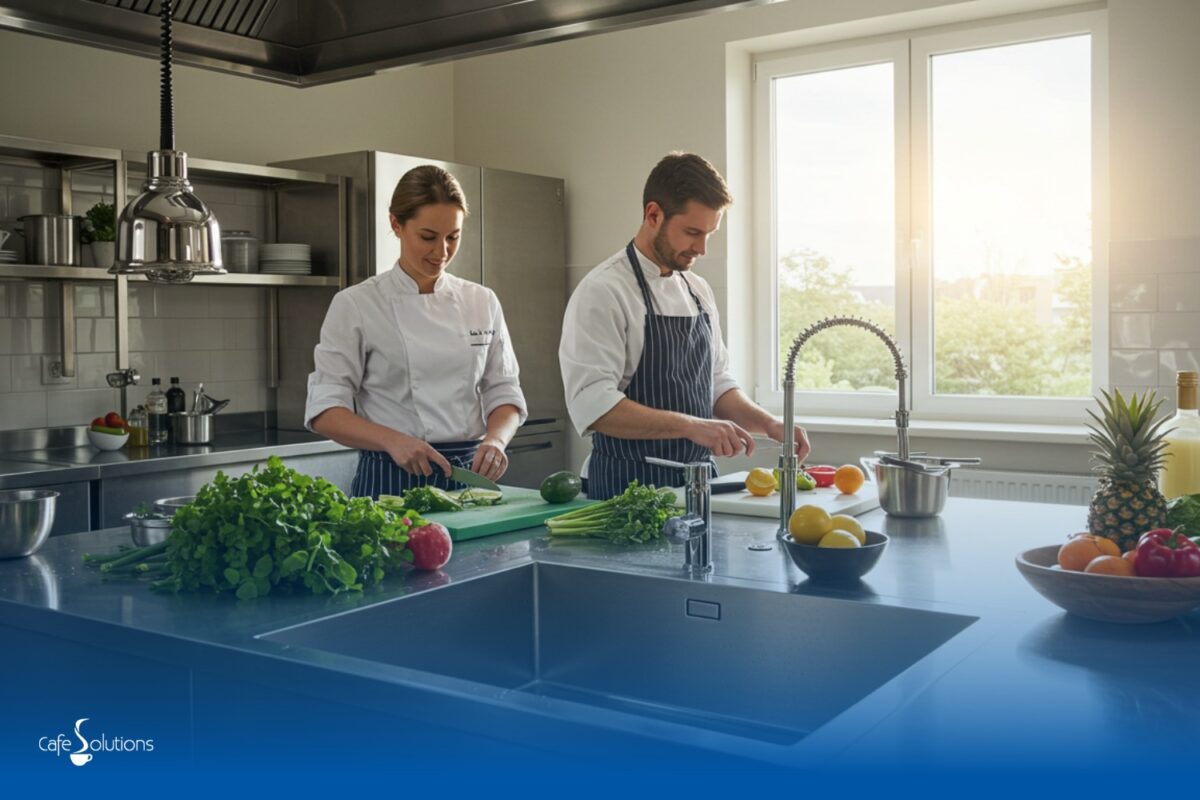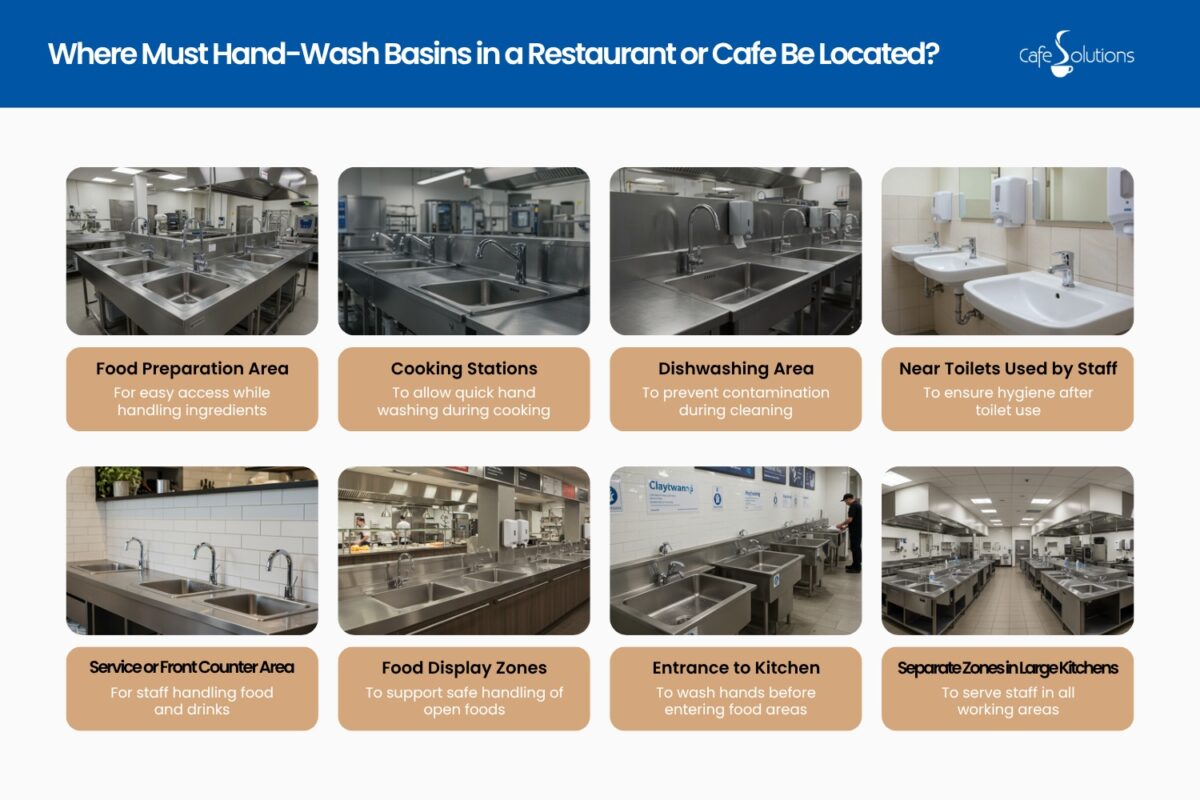Your cart is currently empty!
How Many Sinks are Required in a Commercial Kitchen

In Australia, most commercial kitchens need at least three sinks:
- One for handwashing
- One for food prep
- One for dishwashing
Some commercial kitchens might need a separate sink dedicated to mop use. These health rules depend on where you’re operating in Australia, so your local council may ask for extra sinks depending on your menu and your kitchen layout.
Almost 59% of Australians consider restaurants in their neighbourhood to be very hygienic, according to YouGov. 51% say the same for cafés. At Café Solutions, we often get questions about commercial kitchen sinks and how many restaurants or cafés need to comply with regulations. Here’s a broad overview.
Key Takeaways
- A basic café in Australia usually needs at least three sinks for handwashing, food prep, and dishwashing.
- Handwash basins must be easy to reach and placed in all food and cleaning areas.
- You must not use one sink for more than one task because this can spread germs.
- Large kitchens need more hand basins so every area stays clean and safe.
How Many Sinks does a Basic Café in Australia Usually Need?

A basic café in Australia needs at least three sinks. One is for handwashing, one is for food prep, and one will be for cleaning utensils and dishes. Depending on your café, you might need an extra sink for your floor cleaning, and a separate sink for crockery so that you’re not mixing with things like plates and ashtrays.
Can a Commercial Kitchen Sink Double-Up as a Washtub?
No, a commercial kitchen sink can never double-up as a washtub for dishes or cleaning purposes. This violates health and safety standards in Australia, because one is for food preparation while the other is strictly for cleaning. Always make sure you have a designated place for prepping food, and keep this sink a fair distance away from where you clean.
Hand wash sinks must be close to food prep and serving areas. Your local council may also tell you to get an extra sink if you serve raw meat, seafood, or salads. Even small cafés have to follow these hygiene standards. Plan your restaurant layout early on so that you can avoid having to change things later.
There’s more to it than that, because Food Standards have some meticulous rules about hygiene in a commercial kitchen. Here are four more things you should take note of if you’re a café owner.
What does Standard 3.2.3 Require for Handwash Basins?
The standard 3.2.3 of the Food Standards Code states that handwash basins must be easily accessible. They should also only be used for washing hands, and always supplied with warm running water, soap, and paper towels (a hand dryer is also acceptable).
Each and every basin must be in a spot where those who handle food can use it with as little delay as possible during food preparation. Also make sure the basin isn’t blocked or shared with someone performing any other task.
It must be fixed in place (not portable!) and it must also be located in all of the food handling areas in the kitchen. If your café or kitchen has different zones, each one might need its own handwashing station. Keeping this setup correct will help you pass an inspection, if you even have one.
Is a Single-Bowl Sink Ever Sufficient?
No, a single-bowl sink is almost never enough. Health rules state that you must have separate sinks for handwashing, food prep, and dishwashing. This is to avoid cross-contamination. Very rarely, a single sink might be allowed, but only if your local council approves it. If you can show that you meet strict hygiene standards, it could be allowed.
Do Industrial Dishwashers Count as Sinks?
No, industrial dishwashers don’t ever count as sinks in any commercial kitchen! That’s because they serve different purposes. You still need separate sinks for handwashing, food prepping, and equipment cleaning. Health rules state that each task must be done in its own designated area to stop cross-contamination.
What Sanitising Temperatures are required?
In Australian commercial kitchens, hot water sanitising must reach at least 77 °C for 30 seconds, or 80 °C if you’re using a dishwasher. If you’re using chemical sanitisers, the substance must stay on your surfaces for the time stated on the label. They also have to be food-safe. Both of these methods must kill germs without leaving any harmful residues.
Where Must Handwash Basins in a Restaurant or Café Be Located?

Handwash basins for a restaurant or café must be located in or near all food preparation, food handling, and dishwashing areas. These must be easy to reach so that your staff can wash their hands whenever they need to. They should also be able to do this without leaving their work area.
You must also place one near or inside your establishment’s toilets if they are used by food handlers. Teach your staff that it’s non-negotiable to use these after using the bathroom. Make sure the sink is in clear view, and not hidden behind doors or blocked by anything. You don’t want staff skipping handwashing because the sink is too far!
Here’s a quick overview of what you need and where it should place:
| Location Requirement | Reason for Placement | Must Include |
|---|---|---|
| Food Preparation Area | For easy access while handling ingredients | Warm water soap and paper towels |
| Cooking Stations | To allow quick handwashing during cooking | Warm water soap and paper towels |
| Dishwashing Area | To prevent contamination during cleaning | Warm water soap and paper towels |
| Near Toilets Used by Staff | To ensure hygiene after toilet use | Warm water soap and hand dryer |
| Service or Front Counter Area | For staff handling food and drinks | Warm water soap and paper towels |
| Food Display Zones | To support safe handling of open foods | Warm water soap and paper towels |
| Entrance to Kitchen | To wash hands before entering food areas | Warm water soap and paper towels |
| Separate Zones in Large Kitchens | To serve staff in all working areas | Warm water soap and paper towels |
Are Additional Hand Basins Required in Large Kitchens?
Yes, additional hand basins are required in large kitchens because staff work in different areas and need easy access to wash their hands. Each food prep, cooking, and cleaning zone usually needs its own basin to keep hygiene high and prevent cross-contamination.
When is a Dedicated Food Prep Sink Needed?
You need a food prep sink if your menu includes fresh produce or raw proteins that can cause cross-contamination. Even small cafés must provide one if they prepare these foods on site. Your local council will check that sinks are clearly marked and used only for food prep to keep your kitchen safe and meet hygiene laws.
Where Can You Get Commercial Restaurant and Café Kitchen Sinks?
You can get commercial restaurant and café sinks from Café Solutions. We care about your next inspection, and will help you pass with flying colours. Our stainless steel sinks are designed for commercial kitchens and staff bathrooms, so contact Cafe Solutions to order the right number of sinks today!
FAQs on How Many Sinks are required in a Commercial Kitchen?
What’s the difference between a wash basin and a sink?
A wash basin is only for washing hands, while a sink is used for food prep, dishwashing, or cleaning. You must not use a handwash basin for anything else. Each has a separate role in keeping your café clean and meeting food safety laws.
Do food-display areas affect the sink count requirement of a café?
Yes, food-display areas can affect how many sinks your café needs because they increase food handling zones. If you serve unpackaged or ready-to-eat items from a display, you may need extra handwash basins nearby for hygiene. You might also need a prep sink if food is cut, portioned, or handled in that area.
Must every sink have hot and cold water taps?
Yes, every sink in a commercial kitchen must have both hot and cold water taps so you can control the temperature for safe washing and sanitising. Handwash basins also need warm running water that is comfortable for regular use. Food prep and dishwashing sinks always need hot water for effective cleaning.
Back to Top: How Many Sinks are required in a Commercial Kitchen?

